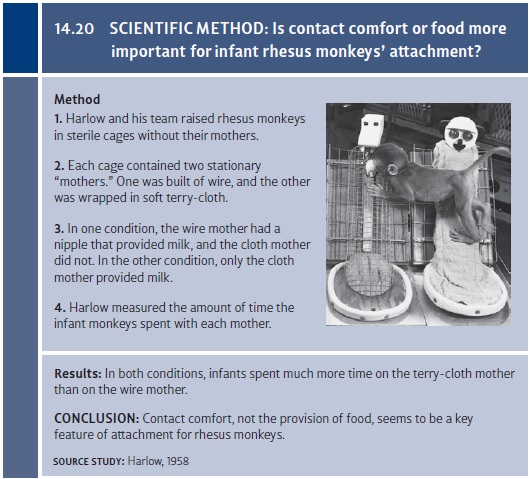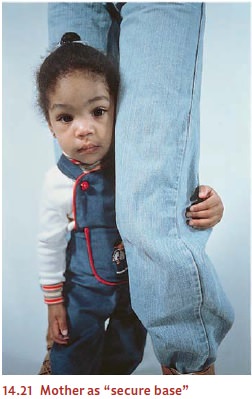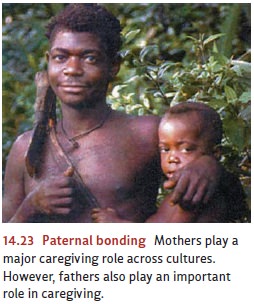Chapter: Psychology: Development
Attachment - Socioemotional Development in Infancy and Childhood
ATTACHMENT
As
children start learning about the social world—developing expectations for how
others will behave and learning to “read” the signals that others provide—they
are also forming their first social relationship, with their primary caregiver,
usually the mother. This is evident in the fact that, when they are between 6
and 8 months old, infants begin to show a pattern known as separation anxiety, in
which they become visibly (and sometimes loudly) upset when their caregiver
leaves the room. This is a powerful indication that the infant has formed an attachment to the caregiver—a strong,
enduring, emotional bond.
This
bond seems to grow out of the psychological comfort the mother provides the
infant. Evidence for this claim comes from many sources, including a series of
classic studies by Harry Harlow (1905–1981). Harlow (e.g., 1958) raised rhesus
monkeys with-out their mothers; each rhesus infant lived alone in a cage that
contained two station-ary figures, one built of wire and the other of soft
terry cloth. The wire figure was equipped with a nipple that yielded milk, but
the terry-cloth model had none. Which figure would the monkey infants
prefer—the one that provided nutrition, or the one that provided (what Harlow
called) “contact comfort”? In fact, the infants spent much


more
time on the terry-cloth “mother” than on the wire figure—especially when they
were frightened. When approached by a clanking mechanical toy, they invariably
rushed to the terry-cloth mother and clung tightly (Figure 14.20).
Is
comfort (and not nutrition) also the key for human attachment? British
psychia-trist John Bowlby argued forcefully that it is. In Bowlby’s view,
children become attached to a caregiver because this adult provides a secure base for the child, a
rela-tionship (and, for the young infant, a place)
in which the child feels safe and protected (Figure 14.21). The child uses the
secure base as a haven in times of threat, and, accord-ing to Bowlby, this
provides the child with the sense of safety that allows her to explore the
environment. The child is able to venture into the unknown, and explore, and
learn, because she knows that, if the going gets rough, she can always return
to the secure base (Waters & Cummings, 2000).
Bowlby
argued that this tendency to form attachments, and to rely on the
psycho-logical comfort of a secure base, is rooted in our evolutionary past,
and this is why we can easily find parallels to human attachment in other
species. For example, consider the process of imprinting, a kind of learning that, in many species, provides the
basis for an infant’s attachment to its mother (e.g., Lorenz, 1935). To take a
specific case, as soon as a duckling can walk (about 12 hours after hatching),
it will approach and fol-low virtually any moving stimulus. If the duckling
follows this moving object for about 10 minutes, an attachment is formed, and
the bird has now imprinted on this object. From this point forward, the
duckling will continue to follow the attachment object, show distress if
separated from it, and run to it in circumstances involving threat.
This
simple kind of learning is usually quite effective, since the first moving
stimu-lus a duckling sees is usually its mother. But imprinting can occur to
other objects, by accident or through an experimenter’s manipulations. In some
studies, ducklings have

been
exposed to a moving toy duck on wheels, or to a rectangle sliding back and
forth behind a glass window, or even to the researcher’s booted legs (Figure
14.22). In each case, the ducklings follow these objects as if following their
mother, uttering plaintive distress calls whenever the attachment object is not
nearby (E. H. Hess, 1959, 1973).
Do
human infants show a similar pattern of imprinting? Some studies have compared
the attachment of infants who had after-birth contact with their mothers to
those who did not (usually due to medical complications in either mother or
baby); the studies found little difference between the groups, and hence
provided no evidence for a specific period during which human newborns form
attachments (Eyer, 1992). Similarly, infants who must spend their initial days
with a nurse or in an incubator do not form a lasting attachment to either.
Clearly, then, the pattern of imprint-to-object-of-first-exposure, common in
many species, is not found in humans.
Even
with these differences between humans and other animals, the fact remains that
human infants form a strong attachment to a caregiver, usually the mother—
presumably because young children in most cultures spend the vast majority of
their time with their mothers (M. E. Lamb, 1987, 1997). What role does this
leave for the father? Infants do develop strong attachments to both parental
figures (Pipp, Easterbrooks, & Brown, 1993), but mothers and fathers
typically behave differently with their infant children, and there are
corresponding differences in attachment. Fathers tend to be more physical and
vigorous in their play, bouncing their children or tossing them in the air. In
contrast, mothers generally play more quietly with their chil-dren, telling
them stories or reciting nursery rhymes and providing hugs and caresses rather
than tumbles and bounces. The children act accordingly, tending to run to the
mother for care and comfort but to the father for active play (Figure 14.23;
Clarke-Stewart, 1978; M. E. Lamb, 1997; Parke, 1981).

Related Topics